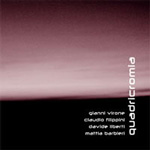Home » Jazz Articles » Live Review » The Clayton-Hamilton Jazz Orchestra Plays with Regina Carter
The Clayton-Hamilton Jazz Orchestra Plays with Regina Carter
The Clayton-Hamilton Jazz Orchestra is exactly the band a director filming a swing-era period piece would want to put in front of the camera.
The Jazz Orchestra, co-led by brothers John and Jeff Clayton as well as Jeff Hamilton, is a classic piece of yesteryear in many ways, replete with matching suits, engraved music stands, and a standard heavy repertoire. After twenty years in existence, however, the group also continues to incorporate new talent and new charisma, managing to maintain a suitably traditional style without growing stale. Its younger members, who currently include Graham Dechter on guitar and Tamir Hendelman on piano, contribute to the band's agelessness, but the playful inquisitiveness and cool camaraderie of its elder members also plays its part. On stage, the co-leaders have developed a tri-part persona that would play as a perfunctory schtick if it weren't so well-executed and upfront about its classic showbiz nature. Conductor John Clayton keeps the show moving with witty-repartee, historical anecdotes, and literally fancy footwork as he dances while signaling the band with well-placed flourishes that sometimes make one wonder whether they are deployed to cue the band or guide the listening audience. Clayton's cool-as-a-cucumber personality is well complimented by brother Jeff and drummer Hamilton's comical contributions as they playfully rib their straight-man leader. For all the staging and playbook joking, however, the Clayton-Hamilton Orchestra is still about delivering a note-perfect, energetic tour through big-band jazz.
Reminding everyone that big-band was originally about barn-raising beats to fuel dancehall escapades, the Jazz Orchestra opened the evening with three hard-hitting swing tunes, including a rambunctious take on Horace Silver's "The Jody Grind", before segueing into a rapid-fire version of Sonny Stitts' bebop tune "The Eternal Triangle". Appropriately, the complete saxophone line were given the chance to solo on this piece, with alto Keith Fiddmont and tenor player Charles Owens delivering stand-out runs.
Slowing things down for what would have been a chance to slow-dance with your sweetheart back in the cotillion days, John Clayton abandoned his conducting post for the bass on the evening's next piece, a beautifully presented version of a Johnny Mandel's composition "Emily". A highlight of the show, this piece confirmed the co-leaders' individual skills as instrumentalists as well as the Orchestra's ability to perform exceptionally crafted arrangements. Finishing off the first half of the performance with a Johnny Hodges tune, it was now time to bring on the night's featured artist, the one-and-only Regina Carter.
For those who have not yet been treated to a live performance of Regina Carter's soul-twinging, boundary-breaking violin playing, she is an outstanding musician in her own right and not to be missed on any occasion. Among the members of the Clayton-Hamilton Jazz Orchestra, she adapted her unique style to fit in like a younger sister, matching their rich character and unshakable proficiency with her challenging persona and youthful mischievousness.
The peak of the night's entertainment, Ms. Carter opened with a moody Duke Ellington blues "Imaginary Frustration" that quickly had the audience eating out of her hand. Playing both bowed and pizzicato, Carter cleverly placed her violin in contrast to the deep throb of the baritone saxophone and unleashed a far ranging solo that expertly moved from clear-toned, vibrant classicism to country-styled free-flowing fiddling. Continuing to impress, both with her solos and her ability to integrate seamlessly into the saxophone line, Carter held everyone's attention for the remainder of the evening as the Orchestra regaled the audience with another five tunes—including a crowd-pleasing rendition of "Bags Groove" and a tongue-in-cheek take on "A Tisket, A Tasket"—pushing the performance well past its scheduled hour and 15 minutes.
Closing with a John Clayton original dedicated to Milt Jackson titled "Reverence", the Orchestra came full circle, presenting a cleverly arranged tune combining excellent musicianship, humor, hard-swinging rhythms, and pleasant showmanship. The Clayton-Hamilton Jazz Orchestra is exactly the band a director filming a swing-era period piece would want to put in front of the camera. Eminently accessible, musically astute, and highly engaging, the Orchestra strikes a perfect balance between retro revivalism and contemporary sensibilities, and in doing so makes a wonderful bridge between jazz's past and its modern manifestations. In short, this is a group you can take your grandmother, mother, and younger cousin to go see without anyone walking away bored, and that is most definitely a feat of great proportions.
Tags
PREVIOUS / NEXT
Support All About Jazz
 All About Jazz has been a pillar of jazz since 1995, championing it as an art form and, more importantly, supporting the musicians who make it. Our enduring commitment has made "AAJ" one of the most culturally important websites of its kind, read by hundreds of thousands of fans, musicians and industry figures every month.
All About Jazz has been a pillar of jazz since 1995, championing it as an art form and, more importantly, supporting the musicians who make it. Our enduring commitment has made "AAJ" one of the most culturally important websites of its kind, read by hundreds of thousands of fans, musicians and industry figures every month.






















